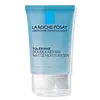What's inside
What's inside
 Key Ingredients
Key Ingredients

 Benefits
Benefits

 Concerns
Concerns

 Ingredients Side-by-side
Ingredients Side-by-side

Water
Skin ConditioningGlycerin
HumectantSilica
AbrasiveBetaine
HumectantNiacinamide
SmoothingCetearyl Isononanoate
EmollientZea Mays Starch
AbsorbentCeramide NP
Skin ConditioningCarbomer
Emulsion StabilisingGlyceryl Stearate Citrate
EmollientSodium Hyaluronate
HumectantSodium Hydroxide
BufferingPerlite
AbsorbentHydroxyacetophenone
AntioxidantCaprylyl Glycol
EmollientXanthan Gum
EmulsifyingWater
Skin ConditioningC12-15 Alkyl Benzoate
AntimicrobialMethylene Bis-Benzotriazolyl Tetramethylbutylphenol
UV FilterCetearyl Isononanoate
EmollientDiisopropyl Adipate
EmollientIsodecyl Neopentanoate
EmollientBis-Ethylhexyloxyphenol Methoxyphenyl Triazine
Skin ConditioningDiethylhexyl Butamido Triazone
UV AbsorberAluminum Starch Octenylsuccinate
AbsorbentButyl Methoxydibenzoylmethane
UV AbsorberPotassium Cetyl Phosphate
EmulsifyingDecyl Glucoside
CleansingBis-Ethylhexyl Hydroxydimethoxy Benzylmalonate
AntioxidantC10-18 Triglycerides
EmollientAcrylates/C10-30 Alkyl Acrylate Crosspolymer
Emulsion StabilisingBenzoic Acid
MaskingCaprylyl Glycol
EmollientDisodium EDTA
Glyceryl Behenate
EmollientGlyceryl Dibehenate
EmollientPropylene Glycol
HumectantSilica
AbrasiveSodium Hydroxide
BufferingTribehenin
EmollientXanthan Gum
EmulsifyingWater, C12-15 Alkyl Benzoate, Methylene Bis-Benzotriazolyl Tetramethylbutylphenol, Cetearyl Isononanoate, Diisopropyl Adipate, Isodecyl Neopentanoate, Bis-Ethylhexyloxyphenol Methoxyphenyl Triazine, Diethylhexyl Butamido Triazone, Aluminum Starch Octenylsuccinate, Butyl Methoxydibenzoylmethane, Potassium Cetyl Phosphate, Decyl Glucoside, Bis-Ethylhexyl Hydroxydimethoxy Benzylmalonate, C10-18 Triglycerides, Acrylates/C10-30 Alkyl Acrylate Crosspolymer, Benzoic Acid, Caprylyl Glycol, Disodium EDTA, Glyceryl Behenate, Glyceryl Dibehenate, Propylene Glycol, Silica, Sodium Hydroxide, Tribehenin, Xanthan Gum
 Reviews
Reviews

Ingredients Explained
These ingredients are found in both products.
Ingredients higher up in an ingredient list are typically present in a larger amount.
Caprylyl Glycol is a humectant and emollient, meaning it attracts and preserves moisture.
It is a common ingredient in many products, especially those designed to hydrate skin. The primary benefits are retaining moisture, skin softening, and promoting a healthy skin barrier.
Though Caprylyl Glycol is an alcohol derived from fatty acids, it is not the kind that can dry out skin.
This ingredient is also used as a preservative to extend the life of products. It has slight antimicrobial properties.
Learn more about Caprylyl GlycolWe don't have a description for Cetearyl Isononanoate yet.
Silica, also known as silicon dioxide, is a naturally occurring mineral. It is used as a fine, spherical, and porous powder in cosmetics.
Though it has exfoliant properties, the function of silica varies depending on the product.
The unique structure of silica enhances the spreadability and adds smoothness, making it a great texture enhancer.
It is also used as an active carrier, emulsifier, and mattifier due to its ability to absorb excess oil.
In some products, tiny microneedles called spicules are made from silica or hydrolyzed sponge. When you rub them in, they lightly polish away dead skin layers and enhance the penetration of active ingredients.
Learn more about SilicaSodium Hydroxide is also known as lye or caustic soda. It is used to adjust the pH of products; many ingredients require a specific pH to be effective.
In small amounts, sodium hydroxide is considered safe to use. However, large amounts may cause chemical burns due to its high alkaline.
Your skin has a natural pH and acid mantle. This acid mantle helps prevent harmful bacteria from breaking through. The acid mantle also helps keep your skin hydrated.
"Alkaline" refers to a high pH level. A low pH level would be considered acidic.
Learn more about Sodium HydroxideWater. It's the most common cosmetic ingredient of all. You'll usually see it at the top of ingredient lists, meaning that it makes up the largest part of the product.
So why is it so popular? Water most often acts as a solvent - this means that it helps dissolve other ingredients into the formulation.
You'll also recognize water as that liquid we all need to stay alive. If you see this, drink a glass of water. Stay hydrated!
Learn more about WaterXanthan gum is used as a stabilizer and thickener within cosmetic products. It helps give products a sticky, thick feeling - preventing them from being too runny.
On the technical side of things, xanthan gum is a polysaccharide - a combination consisting of multiple sugar molecules bonded together.
Xanthan gum is a pretty common and great ingredient. It is a natural, non-toxic, non-irritating ingredient that is also commonly used in food products.
Learn more about Xanthan Gum